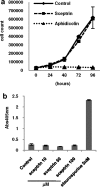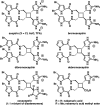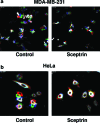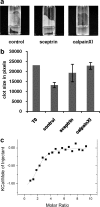Sceptrin, a marine natural compound, inhibits cell motility in a variety of cancer cell lines
- PMID: 20030414
- PMCID: PMC2825093
- DOI: 10.1021/cb900240k
Sceptrin, a marine natural compound, inhibits cell motility in a variety of cancer cell lines
Abstract
Sceptrin, a natural compound produced by various marine sponges, was tested for its effect on cell motility. We report for the first time that sceptrin inhibits cell motility in several cancer cell lines. The compound shows no toxicity at concentrations that are double the amount of sceptrin required for maximal inhibitory effect. Both random and factor-induced migration were impaired, suggesting that sceptrin targets a central process of cell motility machinery. Activity of de novo synthesized sceptrin was indistinguishable from sceptrin purified from Agelas nakamurai, and the inhibitory activity was found to be, at least partially, due to sceptrin's capability to inhibit cell contractility. Additionally, sceptrin was found to bind to monomeric actin, further suggesting a mechanism involving the actin cytoskeleton. Close analogues of sceptrin were synthesized, tested for their effect on cell motility, and found to be either equimolar or less potent compared to the parental compound. Inadvertent cell motility is a key contributing factor in various human diseases, including cancer and chronic inflammation. Marine compounds isolated from sponges have been proven to be an excellent source of metabolites that show biological activities. Given the recently achieved total synthesis of sceptrin in multigram quantities, sceptrin could prove to be an attractive lead molecule for further preclinical testing and development for therapeutic purposes, as well as a useful research tool to elucidate the mechanisms involved in cell motility.
Figures







Similar articles
-
Bromopyrrole Alkaloids from the Sponge Agelas kosrae.Mar Drugs. 2018 Dec 17;16(12):513. doi: 10.3390/md16120513. Mar Drugs. 2018. PMID: 30563015 Free PMC article.
-
Identification of the binding of sceptrin to MreB via a bidirectional affinity protocol.J Am Chem Soc. 2008 Jun 11;130(23):7256-8. doi: 10.1021/ja7114019. Epub 2008 May 14. J Am Chem Soc. 2008. PMID: 18479102
-
A study on the mechanism of action of sceptrin, an antimicrobial agent isolated from the South Pacific sponge Agelas mauritiana.J Antimicrob Chemother. 1993 Oct;32(4):539-50. doi: 10.1093/jac/32.4.539. J Antimicrob Chemother. 1993. PMID: 8288495
-
Total Synthesis of Stelletins through an Unconventional Annulation Strategy.Acc Chem Res. 2021 Apr 6;54(7):1597-1609. doi: 10.1021/acs.accounts.0c00840. Epub 2021 Feb 26. Acc Chem Res. 2021. PMID: 33635622 Review.
-
Antitumor Potential of Marine Natural Products: A Mechanistic Investigation.Anticancer Agents Med Chem. 2018;18(5):702-718. doi: 10.2174/1871520617666170918142811. Anticancer Agents Med Chem. 2018. PMID: 28925876 Review.
Cited by
-
Bromopyrrole alkaloids as lead compounds against protozoan parasites.Mar Drugs. 2010 Jul 14;8(7):2162-74. doi: 10.3390/md8072162. Mar Drugs. 2010. PMID: 20714430 Free PMC article.
-
Fusarisetin A: Scalable Total Synthesis and Related Studies.Chem Sci. 2012 Jan 1;3(12):3378-3386. doi: 10.1039/C2SC21308G. Epub 2012 Aug 23. Chem Sci. 2012. PMID: 23227303 Free PMC article.
-
Role of AGEs in the progression and regression of atherosclerotic plaques.Glycoconj J. 2018 Oct;35(5):443-450. doi: 10.1007/s10719-018-9831-x. Epub 2018 Jul 10. Glycoconj J. 2018. PMID: 29987432 Review.
-
Fusarisetins: Structure-function studies on a novel class of cell migration inhibitors.Org Chem Front. 2014 Apr 1;1(2):135-139. doi: 10.1039/C3QO00067B. Org Chem Front. 2014. PMID: 24910777 Free PMC article.
-
In Vitro and In Vivo Assessment of the Efficacy of Bromoageliferin, an Alkaloid Isolated from the Sponge Agelas dilatata, against Pseudomonas aeruginosa.Mar Drugs. 2020 Jun 23;18(6):326. doi: 10.3390/md18060326. Mar Drugs. 2020. PMID: 32585891 Free PMC article.
References
-
- Newman D. J.; Cragg G. M. (2004) Marine natural products and related compounds in clinical and advanced preclinical trials. J. Nat. Prod. 67, 1216–1238. - PubMed
-
- Butler M. S. (2008) Natural products to drugs: natural product-derived compounds in clinical trials. Nat. Prod. Rep. 25, 475–516. - PubMed
-
- Laport M. S.; Santos O. C.; Muricy G. (2009) Marine sponges: potential sources of new antimicrobial drugs. Curr. Pharm. Biotechnol. 10, 86–105. - PubMed
-
- Faulkner D. J. (2000) Marine natural products. Nat. Prod. Rep. 17, 7–55. - PubMed
-
- Aiello A.; Fattorusso E.; Giordano A.; Menna M.; Muller W. E.; Perovic-Ottstadt S.; Schroder H. C. (2007) Damipipecolin and damituricin, novel bioactive bromopyrrole alkaloids from the Mediterranean sponge Axinella damicornis. Bioorg. Med. Chem. 15, 5877–5887. - PubMed
MeSH terms
Substances
LinkOut - more resources
Full Text Sources
Other Literature Sources

